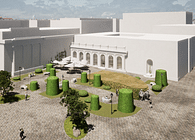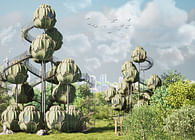
Kharkiv, UA
Introduction
It’s difficult to find a place for comfortable life in contemporary cities. Global urbanization and decrease in the number of really affordable housing are the modern tendencies. Although the idea of constructing more low-rise buildings was recognized prospective and humane, developers often don’t follow these rules, and the cities continue to grow upwards and to press with their giant scale upon the citizens. Also the idea of coliving is developing. But it is not appropriate for everyone; the sad experience in the use of dormitories and communal apartments in the Soviet Union proves it completely. Coliving is more suitable for very young people under 25 years. There are also some problems with work space. More and more people work alone or in small groups. Coworkings are still popular. But it’s sometimes difficult to find a place for some special activities, for example, for a pottery workshop. The main question is where will contemporary social processes lead us in future, and is it possible to create universal architectural decision and scale it for different functions. We think that we have found the answer to that question.
Sources of inspiration
In ancient times human settlements were maximally close to nature. People settled near rivers and forests. According to Ancient Slavic beliefs forests were inhabited by different mythical creatures. One of the brightest representatives of Slavic mythology is Baba Yaga. She is a wise witch who provides her assistance to the heroes of legends. The swamp in the darkest depths of the forest is considered to be her traditional habitual residence. One of her essential attributes is the bony leg that shows her affiliation to supernatural forces. Baba Yaga has one of her legs in our world and another one in the afterlife. She lives in the hut on chicken feet. This construction had a real prototype. It was necessary to build houses on stilts to survive in swamps. Originally such house was situated on high stumps. Running deep into earth, thick roots looked similar to chicken feet. So from a distance such construction seemed like the legendary hut of Baba Yaga.
Socio-cultural and social context
The phrase «the concrete jungle» is widespread in contemporary word. That's pretty much the definition of almost every big city. We have already understood that the extension of the city through the inclusion of nearby settlements and the construction of multi-storey buildings is not the only possible and right way. The reason is that the increase of city area and altitude leads to urban disintegration and destroying of wild nature. It’s important to find the way to improve quality of life and social interactions in existing urban environment. The Baba Yaga’s knowledge could help us to do it. Modern hut can be easily fitted to «the concrete jungle».
Architectural and urban-planning approach
Our idea is to create the unit that could be adapted to any conditions of use. It could be free-standing mini-house, workshop, office, cyclist's house. A number of units can be integrated in hotel, hostel, coworking. The units could be set at the parks, on the roofs of the existing buildings, in unsuitable for permanent structure development areas, i.e. everywhere where there is enough empty space. Decreasing the number of floors to 1 leads to improvement of social communication. Installation at such places as parks, squares, roofs will allow citizens and city guests to know and feel the spirit of the city better.
The unit is partly prefabricated. The unit consists of factory-produced panels. Such panel consists of metal framework and internal space filled by fibroucement plate or brushed board (outer layer), polyurethane foam (central layer) and MDF (inner layer). Electrics, water and sewage pipes are already embedded into panels. Some other parts can be supplied additionally. For example, it could be a terrace. The walls of the unit can be equipped by solar panels. Also rainwater harvesting system can be installed.
Relationship between housing, working space and urban production
People often waste a lot of time in transport. Some of them spend there more than 3 hours daily. The unit is not a permanent structure and it could be transported anywhere if a person wants to change job or just widen social circle. Somebody who hasn’t decided is some city or district appropriate for him or her can rent the unit to live in different areas and change a suitable one.
Innovative content
In this project we don’t offer to use new areas for the development of office buildings, workshops and housing. But we offer to use the existing ones. Since our hut is not a permanent structure but a mobile unit it can be set almost everywhere. It could be connected to existing running water, sewerage and electric power systems. If such connection is impossible due to some reasons, the unit could be connected to autonomous facilities.
Project on our site:
https://www.vizdome.space/en/p...
Status: Competition Entry













